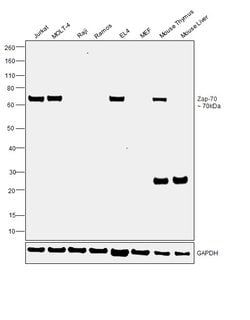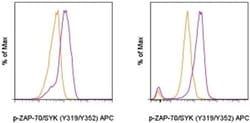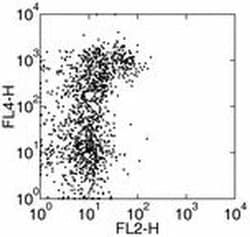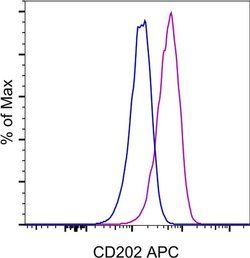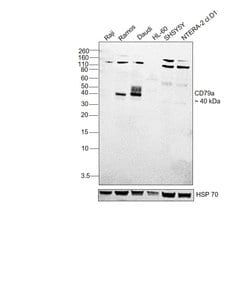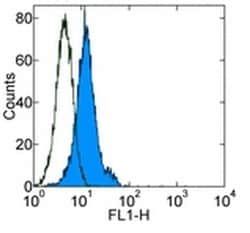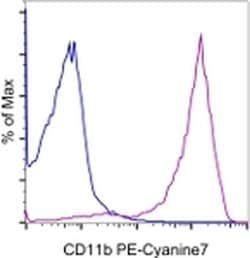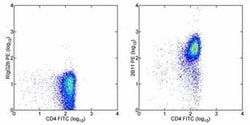Zap-70 Monoclonal Antibody (1E7.2), eBioscience™, Invitrogen™
Manufacturer: Invitrogen
Select a Size
| Pack Size | SKU | Availability | Price |
|---|---|---|---|
| Each of 1 | 50-112-9715-Each-of-1 | In Stock | ₹ 19,936.00 |
50-112-9715 - Each of 1
In Stock
Quantity
1
Base Price: ₹ 19,936.00
GST (18%): ₹ 3,588.48
Total Price: ₹ 23,524.48
Antigen
Zap-70
Classification
Monoclonal
Concentration
0.5 mg/mL
Formulation
PBS with 0.09% sodium azide; pH 7.2
Gene Accession No.
P43403, P43404
Gene Symbols
ZAP70
Purification Method
Affinity chromatography
Regulatory Status
RUO
Gene ID (Entrez)
22637, 7535
Content And Storage
4° C
Form
Liquid
Applications
Flow Cytometry, Immunocytochemistry, Immunoprecipitation, Western Blot
Clone
1E7.2
Conjugate
Unconjugated
Gene
ZAP70
Gene Alias
70 kDa zeta-associated protein; 70 kDa zeta-chain associated protein; ADMIO2; EC 2.7.10.2; FLJ17670; FLJ17679; I79_004087; IMD48; kinase ZAP70; mrtle; mur; Selective T cell defect; Srk; STCD; STD; syk-related protein tyrosine kinase; syk-related tyrosine kinase; Tyrosine-protein kinase ZAP-70; Tyrosine-protein kinase ZAP-70;TZK; TZK; ZA70; Zap70; ZAP-70; Zeta chain associated protein kinase 70kDa; zeta chain of T cell receptor associated protein kinase; zeta chain of T cell receptor associated protein kinase 70; zeta chain of T cell receptor associated protein kinase 70kDa; zeta-chain (TCR) associated protein kinase; zeta-chain (TCR) associated protein kinase 70; zeta-chain (TCR) associated protein kinase 70kDa; zeta-chain associated protein kinase 70kDa; zeta-chain associated protein kinase, 70kD
Host Species
Mouse
Quantity
100 μg
Primary or Secondary
Primary
Target Species
Human, Mouse
Product Type
Antibody
Isotype
IgG1 κ
Description
- Description: The 1E7.2 antibody reacts with human and mouse ZAP-70, the TCRζ-associated protein-70
- ZAP-70 is a cytosolic protein tyrosine kinase (PTK) and a member of the Syk family of proteins
- It is expressed in T and NK cells and is required for TCR signaling and development
- ZAP-70 interacts with the TCR complex by binding to tyrosine-phosphorylated immunoreceptor tyrosine-based activation motifs (ITAMs) present in the invariant subunits of the TCR complex
- Following activation, ZAP-70 is phosphorylated on several tyrosine residues by two mechanisms; an autophosphorylation and a transphosphorylation by the Src family tyrosine kinase Lck1-3
- Tyrosine phosphorylation of ZAP-70 correlates to its increased kinase activity and triggers downstream signaling events
- Mutations in ZAP-70 have been shown to result in a form of Severe Combined Immunodeficiency Syndrome (SCID) in humans
- 1E7.2 was generated against a KLH-peptide sequence corresponding to the human ZAP-70 amino acid residues 282-307
- While ZAP-70 is normally expressed in T and NK cells, several recent studies have also shown high correlation of ZAP-70 positive expression with mutated IgVH expression in B-chronic lymphocytic leukemia (CCL)
- In conclusion, the expression of ZAP-70, which can be measured by intracellular flow cytometry, may serve as a prognostic marker for B-CLL
- Applications Reported: The 1E7
- ZAP-70 is a cytosolic protein tyrosine kinase that is a member of the Syk family of proteins
- ZAP-70 is expressed exclusively in T-cells and natural killer cells and is required for T-cell receptor activation
- Upon T cell antigen receptor (TCR) engagement, ZAP70 is phosphorylated on tyrosines 292, 315 and 319 in the interdomain B, located between the SH2 and kinase domains
- Phosphorylation of both tyrosines 315 (a Vav binding site) and 319 (a Lck binding site) enhances ZAP70 function in mediating lymphocyte signaling, while tyrosine 292 terminates the transient activation of ZAP70 and attentuates lymphocyte signaling.
